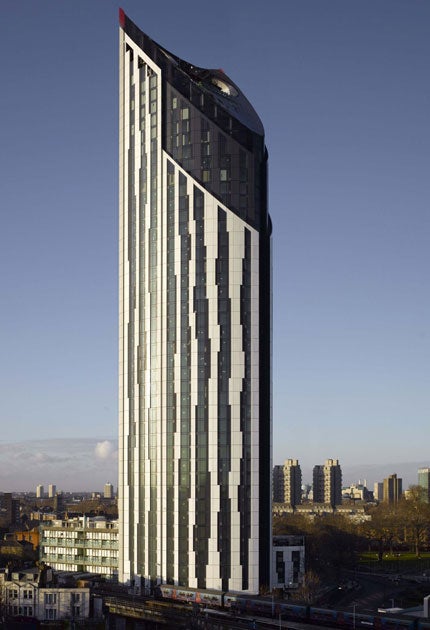
The sun shines and Londoners flock to the rooftops like rosé-thirsty starlings. Finding a space on a bar's terrace, balcony or glorified windowsill is almost as difficult as getting a ticket to Domingo at the Proms. I managed it, though, the other night at the Young Vic. Smugly ensconced on the balcony, my friends and I spotted something sinister on the horizon. There it was, resembling something out of Fritz Lang's Metropolis, a giant black and silver tower topped off with two winking red lights like devil horns.
A vague, geographically suspect discussion ensued. Not one of us could say for sure whether it had always been there or whether it was a new addition to the skyline. A quick Google revealed it to be the new Strata building, at 147 metres and 43 storeys, London's tallest residential block and the opening salvo of the £1.5bn regeneration of Elephant and Castle. In an architectural first, a trio of wind turbines sit on its roof (no summer drinks there, then) to provide 8 per cent of the building's energy. Like all good British skyscrapers (The Gherkin, The Cheese Grater) it has already been given a mundane nickname to keep its feet on the ground even as its head is in the clouds. In fact, Strata has a gender non-specific choice of nicknames – The Electric Razor or The Lipstick.
Last week, Strata had its official unveiling after six years of planning – so you could say that we noticed it at exactly the moment we were supposed to. It can't just have materialised, though and it seems impossible that we hadn't spotted it before. And how do you "unveil" a 147m-tower anyway? Had the builders kept it wrapped up, Christo-style, until last week? No, more likely, as inveterate Tube-dwellers and harried pavement-bargers, we'd just not bothered to notice it.
Since then, in an effort not to become one of those faceless modernist drones flowing over London Bridge in The Waste Land ("And each man fixed his eyes before his feet..."), I've resolved to look up more. As a result, I've spotted several gems – the terracotta dome of the original Angel building in Islington; the cranes starting to sway and blink again over a tentatively resurgent Docklands; even the date on the old manor house next door in Brixton. It's like living in a whole new city – and no scrapping for seats on a crowded roof terrace required.
BNP no match for the might of Marmite
My father has been a lifelong advocate of the power of Marmite. For as long as I can remember he has tried (in vain) to persuade me, my sister and my mother to get over that terrible metallic, yeasty aroma, ignore that awful, unappetising burnt-pan colour and scrape it on our morning toast. And, for as long as I can remember, we have wrinkled our noses, squealed and run off in the opposite direction. Love it or hate it, indeed. But now it seems that Marmite has powers even beyond its advertised iron-richness (and my father's wildest claims). The humble spread could be responsible for bringing down the BNP.
The party adopted Marmite for a political broadcast last year, picturing leader Nick Griffin with a giant jar and adapting the "love it or hate it" slogan into "Love Britain, Vote BNP". Horrified at seeing their brand sullied without permission, Unilever swiftly began legal proceedings for breach of copyright. They have now settled out of court, leaving the BNP with a hefty bill (reportedly up to £170,000) and on the verge of bankruptcy.
Why Griffin and co thought it was a good idea to co-opt a much-loved brand whose slogan includes the word "hate" when they consistently try to dress up their hate-filled policies as reasonable and positive for the wider public is baffling. They might as well have gone for the slogan "Love Britain, Hate Immigrants, Vote BNP". The debacle has, once again, shown up the BNP's repellent true colours. So God bless Marmite – but I'm still not going to put it on my toast.
A festival of inconsisent green credentials
I spent the weekend at Latitude – and very pleasant it was, too. As festivals go, its wide-ranging arts programme is unrivalled: it's the only place you can be tutted at for standing up to watch Sidi Larbi Cherkaoui's new work for Sadler's Wells in the afternoon and then be punched in the face by a screaming Alice Glass during a chaotic Crystal Castles set in the evening.
And that's not to mention the theatre, comedy, poetry, film, cabaret and literature tents. I did wonder, though, if the festival's priorities weren't shown up by the fact that you wouldn't know half of what was happening on its myriad stages unless you shelled out £8 for a Bible-weight programme. Most festival-goers, having already paid £162 for a weekend ticket, ripped out the back two pages with the timetable on and left the 320-page tome in their tents – or, worse still, chucked it away.
This at a festival which devotes a section of its website to its green credentials, trumpeting its biodegradable packaging, recycling bins, re-useable pint glasses and hydrogen fuel cell-powered theatre arena at the same time as suggesting campers might like to "use only phosphate-free shampoo and remember to take a short shower!", buy only fair-trade food and share lifts to the site. An inconvenient, environmentally unsound rip-off.

Join our commenting forum
Join thought-provoking conversations, follow other Independent readers and see their replies